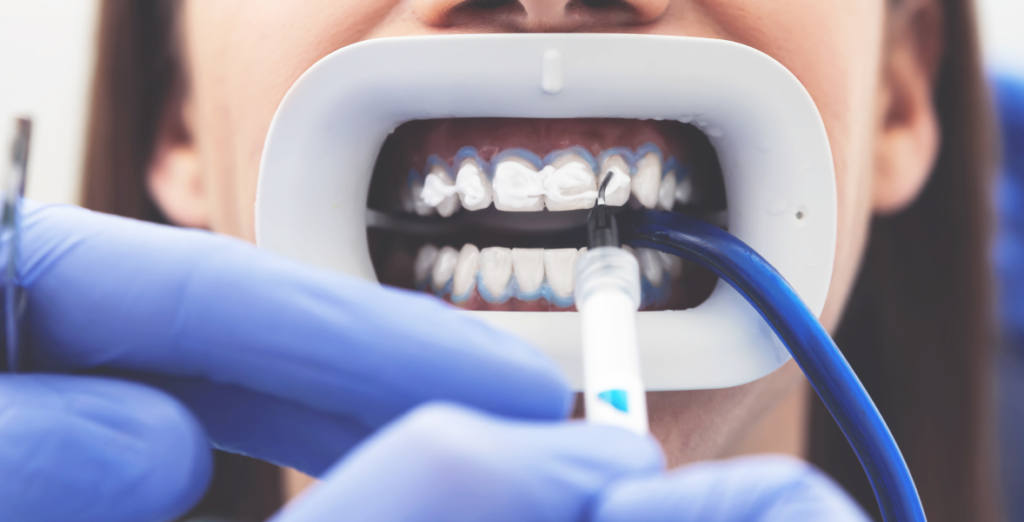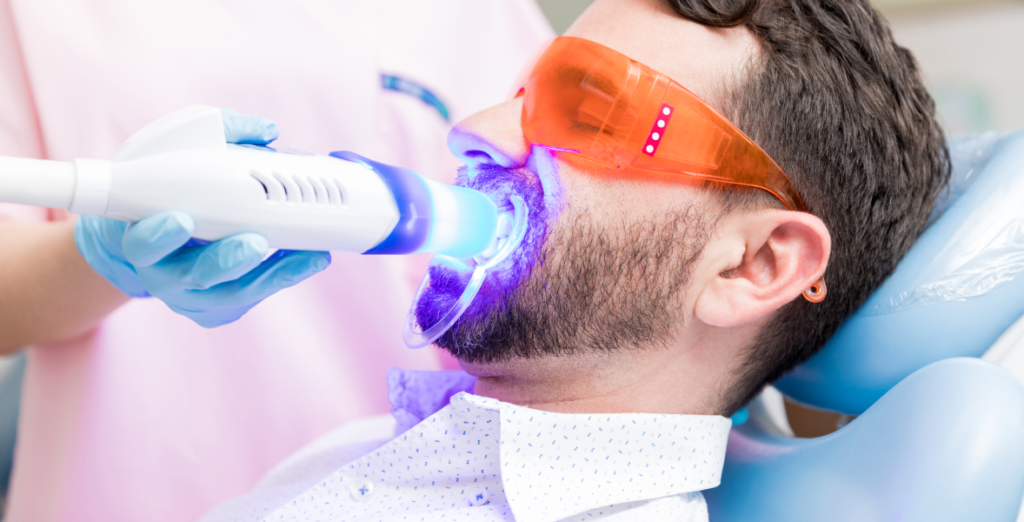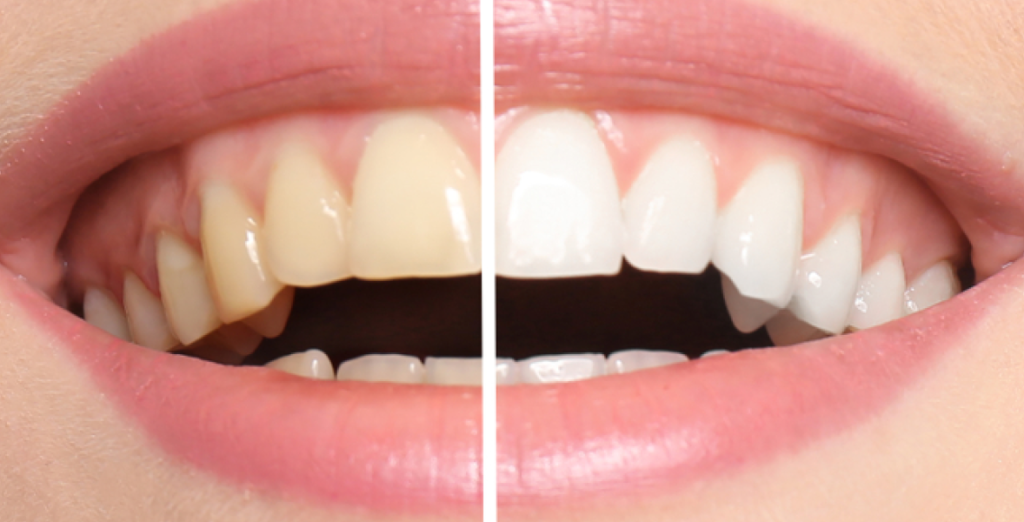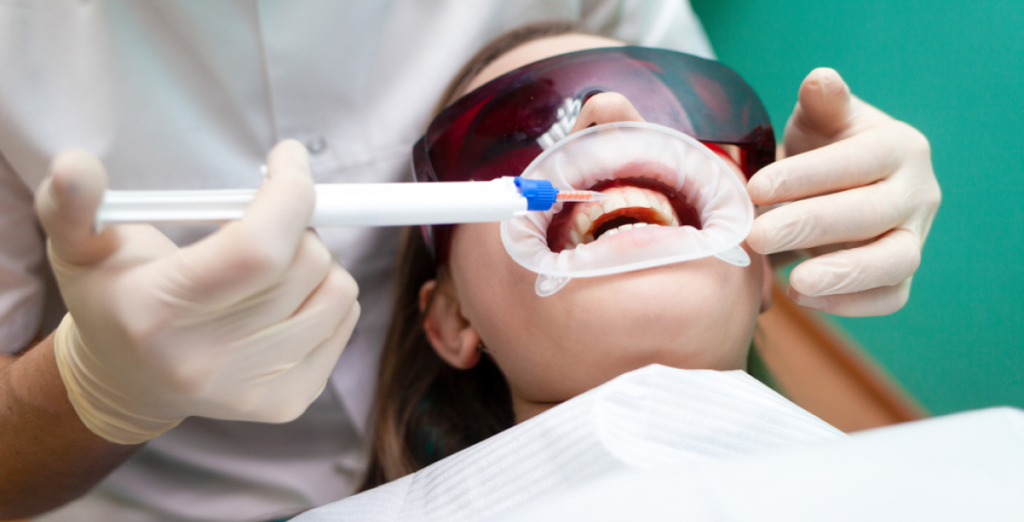This treatment is for you if…
You want your teeth to become white again.
What is teeth whitening?
Teeth whitening is a treatment whose objective is to lighten teeth colour, eliminating stains and discolouration. It is the most popular aesthetic dental treatment.
Teeth whitening is more effective against extrinsic superficial stains. To maintain a brighter colour, the treatment must be repeated occasionally, since it is not a one-off treatment.
Some habits can cause the teeth whitening to begin to fade. Smoking and food and drinks containing colourants can be factors that accelerate this process.
If these harmful habits are avoided and the care recommended by the specialists is taken, it is possible that no other teeth whitening treatment will be required in the next 6-12 months.
What types of teeth whitening exist?
There are different ways to classify the types of teeth whitening. It can be carried out according to the type of teeth, the place in which the teeth whitening is carried out or according to the technology used.
If teeth whitening is differentiated according to the type of teeth, it is necessary to take into account that the teeth may be vital or non-vital. What does that mean? The difference is based on the location of the tooth stain. If the stain is external, vital teeth will be whitened, while if it is on the inside of the teeth, it will be deemed to be the whitening of non-vital teeth.
Teeth whitening of vital teeth
This is the most common teeth whitening technique. It is carried out by applying a gel directly to the surface area of the tooth and it is a treatment that can be carried out both at the surgery and at home.
The gel used contains hydrogen peroxide or carbamide and can be applied more effectively at the dental clinic, since the product percentage is higher and a specialised light is used that enables the teeth whitening to act more quickly.
The vital teeth whitening treatment at the surgery usually lasts from 30 to 90 minutes and is carried out in various sessions. The amount of appointments will depend on the method used, the intensity of the stains and on the degree of whitening wished to be obtained.

Non-vital teeth whitening
This treatment involves the whitening of teeth from the inside. It is carried out when vital teeth whitening does not have any effect, since the stains come from inside the teeth.
In this case, the whitener will be placed within the teeth and a temporary filling will be used. The whitening will remain inside for various days. It will be necessary to change it occasionally when the tooth acquires the white tone required.
In the case of the whitening of vital teeth, a division can be made based on the light technique used. The light activates the gel molecules used to whiten the teeth, increasing the whitening effect. Two types of light are used: laser or LED lighting.

LED teeth whitening
It is a very effective procedure, which consists of activating the whitening gel molecules with a blue light emitted by the LED lamp. Three to four photoactivation sessions will be needed, which may be scheduled into a single appointment that seeks a quicker effect. The result of this teeth whitening may last a long time if good oral hygiene is maintained.
Laser teeth whitening
This is the quickest most effective teeth whitening technique. The laser light activates the whitening gel and penetrates the teeth enamel by increasing their whiteness. However, their effects do not usually last long. Furthermore, the light used does not usually filter infrared emissions, hence, it can cause damage to the teeth’s nerves.
Currently, laser treatment has been substituted by the LED procedure. Both have the same advantages but LED teeth whitening prevents teeth sensitivity, since it is a type of light that does not give off heat. Furthermore, the whitening effect may be more lasting if the LED technique is used.
Advantages of teeth whitening
Teeth whitening is the most common treatment. One of the reasons is that it has numerous aesthetic and mood-changing advantages. Some of the most notable advantages are as follows:
- Whiter smile. A person’s smile is one of the most important characteristics of a person. Having a whiter smile can have a positive influence on patients, improving their mood and confidence, and also on other people, which may perceive you as a more secure trustworthy person.
- Improves confidence. Having whiter teeth is a key factor to improve self-esteem. Socially, having a healthy mouth and smile are highly valued factors, so having whiter teeth can provide you with more confidence and security in yourself.
- Helps to improve hygiene. Teeth whitening requires good oral hygiene to be maintained once the treatment has been performed. Furthermore, a person that wants to have a teeth whitening treatment is generally someone who takes care of their oral health.
- Rapid results. Teeth whitening requires between three to four sessions, but they can be carried out in a single appointment. Unlike many dental treatments, the results of teeth whitening are very quick.
- Painless process. Most dental treatments involve certain discomfort for patients, both at the clinic and, sometimes, on the following days. Teeth whitening does not involve any discomfort for patients.

Teeth whitening treatment phases
Teeth whitening is a quick simple treatment and can be performed at the clinic or at home. Its phases will depend on where the treatment will be carried out, but they are very similar.
Whitening of vital teeth at the clinic. When it is performed at the clinic, teeth whitening will comprise two phases:
1. Firstly, the odontologist will apply a substance that covers and protects the gums around the teeth. Afterwards, they will apply a whitening gel thereto, which will subsequently have to be activated with a light to be effective.
2. If the whitener needs to be activated, a LED or laser lamp will be placed during the treatment time. The treatment may require various sessions, but it can be performed in a single appointment.

Home teeth whitening. Home teeth whitening will be possible using mouth guards that adjust to the teeth and in which whitening gel will be placed. This treatment must be prescribed by a dentist. The phases of this type of treatment are as follows:
1. Firstly, the professional will take impressions of the upper and lower arches and create customised mouth guards that will adapt to the teeth perfectly so that the whitening agent is in contact with them.
2. Once the mouth guards are available, the whitening gel will be placed in the inside of them and they will have to be worn for several hours a day.
Combined whitening: This treatment combines two procedures: firstly, at the clinic, under the supervision of a specialist and, secondly, at the patient’s home.
Frequently asked questions
Teeth whitening is an aesthetic treatment that aims to lighten teeth colour. It can be achieved through the use of whitening agents that contain hydrogen peroxide or carbamide peroxide, which break down the stains into smaller particles, making the colour less concentrated and teeth whiter.
Many people that wish to improve the appearance of their teeth may be candidates for teeth whitening. However, not all types of discolouration can be treated with whitening, hence the dentist must perform an assessment to determine if the treatment is adequate.
There are various options for teeth whitening. But the safer recommendable whitening treatments are those performed at a dental clinic by an expert, with more effective and safer technology, such as photo-activation.
The effect of teeth whitening may last from a few months to various years, depending on factors such as diet and oral hygiene habits. Avoid food and drinks that stain teeth and the regular use of dental care products may help to prolong results.
Teeth whitening is generally safe when it is performed in line with the instructions of a dental professional. Some people may experience temporarily sensitive teeth or gum irritation, but these effects are usually temporary and slight.
Prices
The amounts indicated have been estimated in line with a full treatment, in accordance with the parameters in the table. Includes: study, treatment and check-ups during the treatment, so it serves as a guide and is of a merely informative non-contractual nature. The personalised treatment will be examined in line with the medical prescription. Prices can be increased if additional costs are incurred as a result of the requests made by each customer. Price valid until 31 December 2024 except in the event of a typing error.

